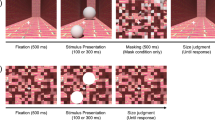Abstract.
The human nervous system constructs a Euclidean representation of near (personal) space by combining multiple sources of information (cues). We investigated the cues used for the representation of personal space in a patient with visual form agnosia (DF). Our results indicated that DF relies predominantly on binocular vergence information when determining the distance of a target despite the presence of other (retinal) cues. Notably, DF was able to construct an Euclidean representation of personal space from vergence alone. This finding supports previous assertions that vergence provides the nervous system with veridical information for the construction of personal space. The results from the current study, together with those of others, suggest that: (i) the ventral stream is responsible for extracting depth and distance information from "monocular" retinal cues (i.e. from shading, texture, perspective) and (ii) the dorsal stream has access to binocular information (from horizontal image disparities and vergence). These results also indicate that DF was not able to use size information to gauge target distance, suggesting that intact temporal cortex is necessary for "learned size" to influence distance processing. Our findings further suggest that in neurologically intact humans, object information extracted in the ventral pathway is combined with the products of dorsal stream processing for guiding prehension. Finally, we studied the "size-distance paradox" in visual form agnosia in order to explore the cognitive use of size information. The results of this experiment were consistent with a previous suggestion that the paradox is a cognitive phenomenon.
Similar content being viewed by others
Author information
Authors and Affiliations
Additional information
Electronic Publication
Rights and permissions
About this article
Cite this article
Mon-Williams, M., Tresilian, J.R., McIntosh, R.D. et al. Monocular and binocular distance cues: insights from visual form agnosia I (of III). Exp Brain Res 139, 127–136 (2001). https://doi.org/10.1007/s002210000657
Received:
Accepted:
Issue Date:
DOI: https://doi.org/10.1007/s002210000657




